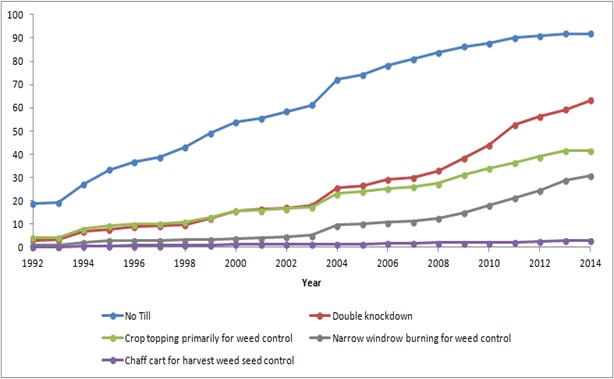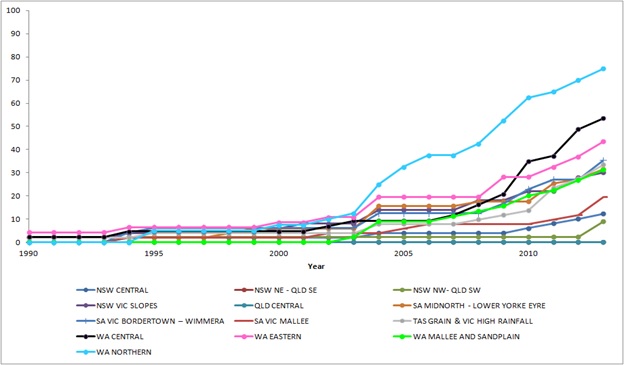Hitting the right target - what are our most costly weeds?
Author: Rick Llewellyn, David Ronning, Allan Mayfield, Steve Walker, Jackie Ouzman and Michael Clarke | Date: 10 Feb 2015
Rick Llewellyn1, David Ronning2, Allan Mayfield3, Steve Walker4, Jackie Ouzman1and Michael Clarke2,
1CSIRO; 2AgEconPlus; 3Allan Mayfield Consulting; 4 Uniquest University of Queensland.
GRDC project code: CSA00043
Keywords: weed management, control, costs, herbicides.
Take home messages
- Brome grass is now one of the most costly winter weeds across the southern region.
- Investment in summer weed control is relatively high but the cost of yield reductions due to the major summer weeds in the southern region (e.g. heliotrope, melons, fleabane) remain substantial, suggesting opportunities for profitable practice change.
- Overall, growers are investing heavily in winter weed control and are managing to keep weed densities and the cost of yield losses relatively low compared to management costs.
Background
Weed management involves a range of constantly evolving targets leading to shifting priorities and threats. The last major national study of the distribution and economic impact of weeds in Australian cropping systems was conducted over 15 years ago (Jones et al 2000). In 2014-15 GRDC supported this new study to identify the costs of weeds and their management across Australian grain growing regions, crops and weed types. A major aim is to identify where the greatest costs are being incurred and inform investment in improved weed management strategies.
Methodology
The study covers the 13 major agro-ecological zones across the Western, Southern and Northern grain growing regions and the major crop types of wheat, barley, oats, canola, pulses and grain sorghum. It also examines the rate of uptake of established and emerging weed management practices.
Data for the analysis is drawn from interviews with over 600 grain growers selected at random to represent each agro-ecological zone, used in conjunction with ABS statistics on crop production and information on practice costs from regional agronomists and a range of other sources. The results refer to annual costs (assumed to be the 2013-14 season) but generally capture averages over the past three seasons to minimise the influence of seasonal extremes in different agroecological zones.
The distribution and economic importance of weeds to Australian grain growers is evaluated for in-crop and fallow weeds, including the cost of herbicide and non-herbicide practices as well as the cost of yield losses due to weeds. Data on extent and typical density for the most common residual weeds came from growers and was used with yield loss functions for each weed to determine yield losses.
This brief preliminary summary focuses on trends in use of weed management practices and the most costly weeds estimated in Southern region agroecological zones.
Results and discussion
Costs
The most costly weeds nationally in terms of yield loss in winter crops are ryegrass, wild radish, wild oats, brome and wild turnip. Results for costs of yield loss in cereal crops are shown in Table 1. Ryegrass remains the major weed in terms of the cost of herbicide resistance with the cost being greater than the sum of all other forms of resistance.
The increased importance of brome grass is the most notable difference from the weed rankings from the 1998 study. This is reinforced by the high ranking of brome when growers were asked to directly state the weeds most costly to control.
Table 1 Cost of residual weeds on yield loss in winter cereals for the Southern region and its agro-ecological zones.
|
SOUTHERN REGION
|
SA MIDNORTH - LOWER YORKE EYRE
|
||||||||||||||||||||||||||||||||||||||||
|
NSW CENTRAL
|
SA VIC BORDERTOWN – WIMMERA
|
||||||||||||||||||||||||||||||||||||||||
|
NSW VIC SLOPES
|
SA VIC MALLEE
|
For the Southern Region, the most important summer weeds based on estimated reduction in subsequent crop yield potential were: heliotrope, melons, fleabane, panic grass, caltrop, Lincoln weed and windmill grass.
Growers in the southern region were estimated to be incurring losses of $23/ha due to the impact of summer weeds on subsequent crop yields, with $17/ha of cropped land estimated to be spent on summer weed control on average.
Practices
Looking at national trends in the proportion of growers starting to use a range of weed management practices (and no-till), the use of the double knockdown continues to increase with rapid rises in the last six years, reflecting the increasing threat of glyphosate resistance (Figure 1). The relatively rapid rise of narrow windrow burning from a low base 10 years ago is also demonstrated. Large differences in adoption rates between agroecological zones are shown in Figure 2, highlighting the rapid adoption in WA and the likelihood of further increases in use of this practice in many areas.

Figure 1. Cumulative adoption (% of growers who have used practice) for selected weed management practices and no-till across all regions.

Figure 2. Cumulative adoption (% of growers who have used practice) of narrow windrow burning by agroecological zone.
Conclusion
Australian grain growers are investing heavily in winter weed management to keep the cost of crop yield losses relatively low, despite increasing levels of herbicide resistance. This is mostly through herbicide-based methods, although use of some non-herbicide practices such as narrow windrow burning is rapidly increasing. The cost of both yield loss due to summer weeds and investment in summer weed control is high, suggesting this is an area with substantial potential for profitable practice change. Further detail will be included in a full report to be released in mid-2015.
Contact details
Rick Llewellyn
CSIRO, Waite Campus
08 83038502
GRDC Project Code: CSA00043,
Was this page helpful?
YOUR FEEDBACK
